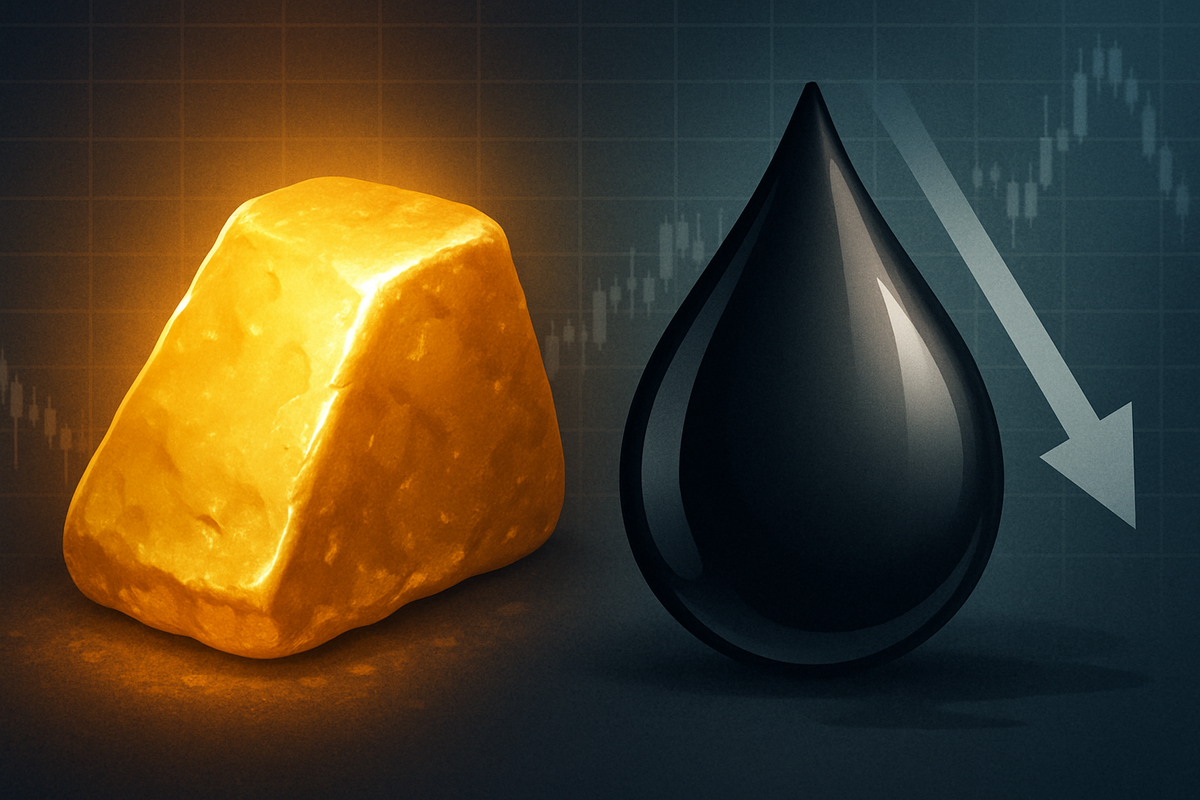
The global financial landscape is currently witnessing a fascinating divergence in the fortunes of two of its most pivotal commodities: gold and crude oil. While gold continues its impressive ascent, solidifying its role as a resilient safe haven amidst a backdrop of geopolitical turmoil and economic uncertainty, crude oil prices are experiencing a notable decline, influenced by increasing supply and a more tempered demand outlook. This contrasting performance carries immediate and significant implications for the global economy, inflation, and the strategic decisions of investors worldwide.
Geopolitical Tensions and Supply Dynamics Drive Commodity Movements
The current state of commodity markets is a complex tapestry woven from geopolitical tensions, shifting supply-demand fundamentals, and evolving monetary policies. Gold, often seen as a barometer of global anxiety, has surged to unprecedented levels, trading between $3,372 and $3,389 per troy ounce as of August 26, 2025. This remarkable rally, which saw gold prices increase by over 25% in 2024 and continue to set new all-time highs in 2025, is largely attributable to a confluence of factors. Heightened geopolitical risks, particularly ongoing conflicts in the Middle East and Eastern Europe, coupled with uncertainties surrounding U.S. trade policy, have significantly bolstered gold's appeal. Furthermore, a depreciating U.S. dollar, expectations of future interest rate cuts by central banks, persistent inflationary pressures, and robust demand from central banks globally have all contributed to its upward trajectory.
In stark contrast, crude oil prices have been on a downward trend. Brent crude oil is currently trading around $68.10 - $68.74 per barrel, while WTI crude oil hovers around $64.45 - $64.48 per barrel. Both benchmarks have seen declines over the past month and year-over-year. While geopolitical tensions, such as the Russia-Ukraine war and Middle Eastern instability, have historically driven oil prices higher, the current market is being shaped by other powerful forces. The coordinated production policies of OPEC+ members, particularly their plans to gradually unwind voluntary production cuts, are expected to contribute to increasing global inventories. Moreover, non-OPEC production, led by countries like the United States, Brazil, and Norway, is forecasted to rise at a faster pace than global demand growth in 2025, creating an oversupply scenario. A slowdown in global GDP growth also plays a role, reducing overall oil demand and contributing to price declines.
Winners and Losers in a Shifting Commodity Landscape
The divergent paths of gold and crude oil create a clear distinction between potential winners and losers in the financial markets.
Winners:
- Gold Mining Companies: Companies like Barrick Gold Corporation (NYSE: GOLD) and Newmont Corporation (NYSE: NEM) are direct beneficiaries of rising gold prices. Higher prices translate to increased revenue and profitability, potentially leading to higher stock valuations and increased investor interest. These companies may also see opportunities to expand exploration and production efforts.
- Investors in Gold-Backed ETFs and Physical Gold: Individuals and institutions holding gold-backed exchange-traded funds (ETFs) or physical gold are experiencing significant gains, reinforcing gold's role as a reliable store of value and a hedge against inflation and economic uncertainty.
- Consumers and Energy-Dependent Industries: Lower crude oil prices are a boon for consumers, as reduced fuel costs translate to more disposable income. Industries heavily reliant on energy, such as transportation and manufacturing, will also see their operational costs decrease, potentially boosting their profit margins. Airlines like Delta Air Lines (NYSE: DAL) and Southwest Airlines (NYSE: LUV) could see significant cost savings.
- Companies in Renewable Energy: While not directly tied to oil prices, the emphasis on energy security due to geopolitical risks and the long-term trend of diversifying away from fossil fuels could accelerate investments in renewable energy companies. This could benefit companies like NextEra Energy, Inc. (NYSE: NEE) and Enphase Energy, Inc. (NASDAQ: ENPH).
Losers:
- Oil and Gas Exploration and Production Companies: Companies heavily invested in crude oil exploration and production, such as ExxonMobil Corporation (NYSE: XOM) and Chevron Corporation (NYSE: CVX), may face reduced profitability due to lower oil prices. While they are large, diversified companies, a sustained downturn in oil prices can impact their upstream segments.
- Oilfield Services Companies: Businesses that provide services to the oil and gas industry, including drilling, well completion, and equipment, could see a decrease in demand for their services as oil companies scale back operations in response to lower prices. Companies like Schlumberger Limited (NYSE: SLB) could be affected.
- Oil-Exporting Nations: Countries whose economies are heavily dependent on oil exports will experience a decline in government revenues, potentially leading to budget deficits and economic instability.
- Investors with Significant Exposure to Oil Futures: Traders and investors with long positions in crude oil futures contracts would incur losses as prices fall.
Industry Impact and Broader Implications
The current commodity landscape has far-reaching implications, extending beyond immediate market fluctuations to influence broader industry trends, regulatory frameworks, and global economic stability.
The sustained rally in gold reinforces a broader industry trend towards safe-haven assets during periods of heightened global uncertainty. This trend is not new; historical precedents, such as the 2008 financial crisis and various geopolitical flashpoints, have consistently shown gold's resilience. The current environment, characterized by ongoing conflicts and economic anxieties, further solidifies gold's role as a crucial component of diversified investment portfolios. This could lead to increased institutional and retail investment in gold, potentially driving further price appreciation.
Conversely, the decline in crude oil prices, despite persistent geopolitical risks, highlights a shift in the supply-demand dynamic. The increasing non-OPEC production, particularly from the United States, is a significant factor. This trend could lead to a re-evaluation of energy security strategies globally, with nations potentially seeking to diversify their energy sources and reduce reliance on volatile regions. Regulatory bodies may also face pressure to encourage domestic energy production or invest further in renewable energy infrastructure to mitigate future supply shocks. The ripple effects on competitors and partners in the energy sector are substantial. Smaller, less diversified oil and gas companies may struggle to remain profitable in a lower-price environment, potentially leading to consolidation within the industry. Furthermore, the reduced revenue for oil-exporting nations could strain international relations and impact global trade balances.
What Comes Next
The immediate future of commodity markets will likely remain highly sensitive to geopolitical developments and central bank policies. In the short term, any escalation or de-escalation of conflicts in the Middle East or Eastern Europe could trigger significant price movements in both crude oil and gold. Similarly, pronouncements from central banks regarding interest rates and inflation will continue to exert considerable influence. A more dovish stance from the U.S. Federal Reserve, for instance, could further bolster gold prices, while a more hawkish approach might temper its ascent.
In the long term, the trajectory of these commodities will be shaped by evolving global energy policies and the ongoing transition to a greener economy. While crude oil prices may face continued downward pressure from increasing supply and the push for renewable energy, demand from emerging economies could provide some support. Gold, on the other hand, is expected to maintain its appeal as a safe haven, particularly if global economic uncertainties persist. Potential strategic pivots for energy companies include further diversification into renewable energy sources and investments in carbon capture technologies. Market opportunities may emerge in the form of distressed assets in the oil and gas sector, while challenges will include navigating a volatile pricing environment and adapting to stricter environmental regulations. Investors should prepare for continued volatility and consider a balanced portfolio that accounts for both the defensive qualities of gold and the cyclical nature of crude oil.
Conclusion
The current state of commodity prices presents a compelling narrative of divergence, with gold ascending to new heights as a beacon of stability amidst global turmoil, while crude oil navigates a more challenging landscape of increasing supply and moderating demand. The key takeaways from this period are the enduring power of geopolitical events to shape market dynamics, the growing importance of supply-side factors in the oil market, and gold's reinforced role as a critical safe-haven asset.
Moving forward, the market will remain highly sensitive to a complex interplay of factors, including the resolution of ongoing conflicts, the pace of global economic growth, and the monetary policy decisions of major central banks. Investors should closely monitor these developments, paying particular attention to inflation data, interest rate expectations, and any shifts in global energy policy. The lasting impact of this period may be a re-evaluation of traditional investment strategies, with a greater emphasis on portfolio diversification and the inclusion of assets that offer protection against both inflation and systemic risk. The tale of these two commodities underscores the dynamic and often unpredictable nature of financial markets, urging investors to remain agile and informed in the months to come.





